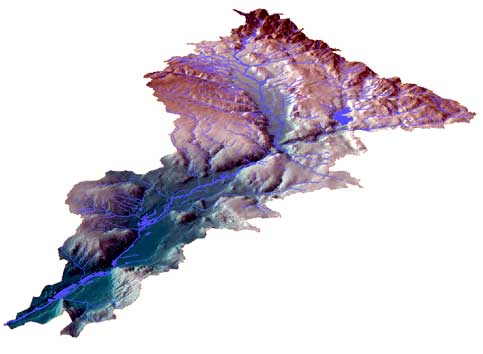Scientific Investigations Report 2006–5160

|
The Hydrological Simulation Program Fortran (HSPF) was used to simulate the concentrations and loads of fecal coliform and nitrate for streams in the Mad River Basin in west–central Ohio during the period 1999 through 2003. The Mad River Basin was divided into subbasins that were defined either by the 14–digit Hydrologic Unit (HU) boundaries or by streamflow–gaging–station locations used in the model. Model calibration and simulation processes required the formation of nine meteorologic zones to input meteorologic time–series data and water–quality data.
Sources of fecal coliform and nitrate from wastewater–treatment discharges and combined sewer overflow discharges (CSOs) within the City of Springfield were point sources simulated in the model. Failing septic systems and cattle with direct access to streams were nonpoint sources included in the study but treated in the model as point sources. Other nonpoint sources were addressed by adjusting interflow and ground–water concentrations in the subsurface and maximum storage capacities and accumulation rates of the simulated constituents on the land surface for each meteorologic zone. Simulation results from the calibrated model show that several HUs exceeded the water–quality standard of 1,000 colony–forming units per 100 mL for fecal coliform based on the maximum 30–day geometric mean. Most HUs with high fecal coliform counts were within or downstream from the City of Springfield. No water–quality standard has been set for instream nitrate concentrations; however, the Ohio Environmental Protection Agency (Ohio EPA) considered a concentration of 5 mg/L or greater to be of concern. Simulation results indicate that several HUs in the agricultural areas of the basin exceeded this level.
The calibrated model was modified to create scenarios that simulated loads of fecal coliform and nitrate that were either reduced or eliminated from selected sources. The revised models included the elimination of failing septic systems, elimination of direct access of cattle to streams, decrease in fecal coliform loads from the CSOs and selected wastewater–treatment facilities, and decrease in nitrate loads from land surfaces. The fecal coliform source–reduction model decreased the fecal coliform concentrations below a target concentration of 1,000 colonies per 100 milliliters for all HU outlets and decreased the load at the mouth of the Mad River by 73 percent. The nitrate source–reduction model decreased some HU mean concentrations to 5 milligrams per liter or less and decreased the load at the mouth of the Mad River by 52 percent. Other reduction scenarios may be run by Ohio EPA with the intent of identifying a management strategy that will attain a target concentration for the Mad River Basin.
This report is contained in the following file:
sir2006-5160.pdf (3.89MB)
The PDF file is readable with Adobe Acrobat Reader. The reader is available for
free download from
Adobe Systems Incorporated.
![]()
Abstract
Introduction
Purpose and Scope
Previous Studies
Basin Description
Physical and Hydrologic Setting
Climate
Hydrogeology
Soils
Land Cover
Water Quality
Designated Uses
Fecal Coliform
Nitrate
Simulation of Streamflow and Water Quality
Description of Model
Meteorologic Data
Streamflow Data
Model Segmentation
Model Limitations
Hydrologic Simulation
Hydrologic Calibration
Sensitivity Analysis
Assumptions
Water–Quality Simulation
Source Representations
Wastewater–Treatment Plants
City of Springfield Combined Sewer Overflows (CSOs)
Cattle in Streams
Failed Septic Systems
Commercial–Fertilizer and Manure Applications
Atmospheric Deposition
Observed Water–Quality Data
Water–Quality Calibration
Sensitivity Analysis
Simulation Results
Simulated Loads and Concentrations
Fecal Coliform
Nitrate
Result of Load–Reduction Simulations
Fecal Coliform
Nitrate
TMDL Requirements
Seasonal and Streamflow Variability
Margin of Safety
Target Concentrations
Summary and Conclusions
Acknowledgments
References Cited
Appendix 1. Percentage of each 14 digit unit with a given land–cover classification
Appendix 2. Values of selected parameters used in calibrated model to simulate streamflow
Appendix 3. Parameter values used in calibrated model to simulate fecal coliform concentrations
Appendix 4. Parameter values used in calibrated model to simulate nitrate concentrations
For more information about the USGS and its products:
Telephone: 1–888–ASK-USGS
World Wide Web: www.usgs.gov
Send questions or comments about this report to the author, David C. Reutter, at dreutter@usgs.gov, 641-430-7732.
For more information about USGS activities in Ohio, visit the USGS Ohio Water Science Center home page.